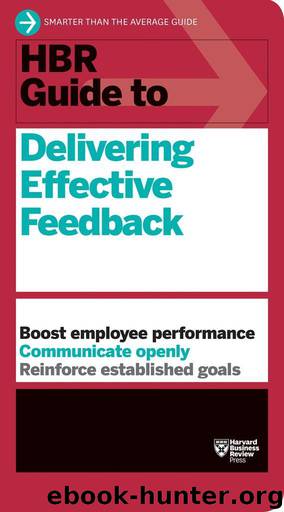HBR Guide to Delivering Effective Feedback (HBR Guide Series) by Harvard Business Review

Author:Harvard Business Review
Language: eng
Format: mobi
Publisher: Harvard Business Review Press
Published: 2016-04-18T14:00:00+00:00
* * *
Adapted from content posted on hbr.org on February 29, 2008
Section 2
Formal Performance Appraisals
Chapter 8
Delivering an Effective Performance Review
by Rebecca Knight
When performance review season arrives, you know the drill. Drag each of your direct reports into a conference room for a one-on-one, hand them an official-looking document, and then start in with the same, tired conversation. Say some positive things about what the employee is good at, then some unpleasant things about what he’s not good at, and end—wearing your most solicitous smile—some more ego strokes. The result: a mixed message that leaves even your best employees feeling disappointed.
Your formal review sessions with your employees don’t need to be so tiresome—or confusing. If you take the right approach, appraisals are an excellent opportunity to keep solid performers moving onward and upward and redirect the poor ones.
What the Experts Say
For many employees, a face-to-face performance review is the most stressful work conversation they’ll have all year. For managers, the discussion is just as tense. “What a performance appraisal requires is for one person to stand in judgment of another. Deep down, it’s uncomfortable,” says Dick Grote, author of How to Be Good at Performance Appraisals. Evaluating an employee’s job performance should consist of more than an annual chat, according to James Baron, the William S. Beinecke Professor of Management at Yale School of Management. Performance management is a process, he says: “Presumably, you’re giving a tremendous amount of real-time feedback, and your employees are people you know well. Hopefully, your relationship can survive candid feedback.” No matter what kind of appraisal system your company uses, here are several strategies to help you make performance review season less nerve-racking and more productive.
Set expectations early
The performance review doesn’t start with a sit-down in the spare conference room. You must be clear from the outset how you’ll evaluate your employees. Grote suggests holding “performance planning” sessions with each of your direct reports at the beginning of the year to discuss that person’s goals and your expectations. (See chapter 11, “How to Set and Support Employee Goals.”) “You’ll see immediate improvement in performance because everyone knows what the boss expects,” he says. “And it earns you the right to hold people accountable at the end of the year.” Listen carefully to your employees’ personal ambitions, as it will inform the way you assess their work. “Often times, managers are evaluating performance with out necessarily knowing what that person’s career aspirations are. We often assume that every one wants to be CEO. But that’s not always the case,” says Baron. Understanding what your direct reports want from their careers will help you figure out ways to broaden their professional experiences.
Lay the groundwork
About two weeks before the face-to-face review, ask your employee to jot down a few things he’s done over the last year that he’s proud of. This will both help refresh your memory and “put a positive focus on an event that is so often seen as negative,” says Grote. Next, review other notes
Download
This site does not store any files on its server. We only index and link to content provided by other sites. Please contact the content providers to delete copyright contents if any and email us, we'll remove relevant links or contents immediately.
Tools of Titans by Timothy Ferriss(8178)
Change Your Questions, Change Your Life by Marilee Adams(7595)
Deep Work by Cal Newport(6843)
Man-made Catastrophes and Risk Information Concealment by Dmitry Chernov & Didier Sornette(5895)
Playing to Win_ How Strategy Really Works by A.G. Lafley & Roger L. Martin(5830)
Digital Minimalism by Cal Newport;(5618)
Big Magic: Creative Living Beyond Fear by Elizabeth Gilbert(5573)
The Slight Edge by Jeff Olson(5331)
Ego Is the Enemy by Ryan Holiday(5261)
The Motivation Myth by Jeff Haden(5137)
Stone's Rules by Roger Stone(5004)
The Laws of Human Nature by Robert Greene(4958)
Tuesdays with Morrie by Mitch Albom(4647)
Eat That Frog! by Brian Tracy(4404)
Rising Strong by Brene Brown(4358)
Skin in the Game by Nassim Nicholas Taleb(4139)
The Money Culture by Michael Lewis(4048)
Bullshit Jobs by David Graeber(4038)
Skin in the Game: Hidden Asymmetries in Daily Life by Nassim Nicholas Taleb(3893)
